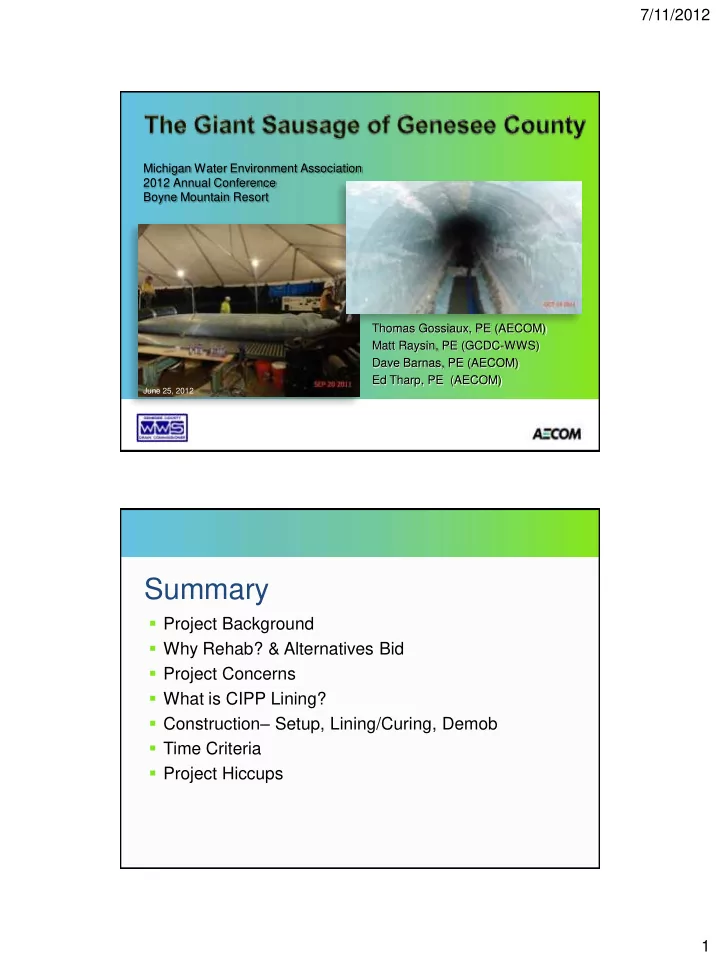

7/11/2012 Michigan Water Environment Association 2012 Annual Conference Boyne Mountain Resort Thomas Gossiaux, PE (AECOM) Matt Raysin, PE (GCDC-WWS) Dave Barnas, PE (AECOM) Ed Tharp, PE (AECOM) June 25, 2012 Summary Project Background Why Rehab? & Alternatives Bid Project Concerns What is CIPP Lining? Construction – Setup, Lining/Curing, Demob Time Criteria Project Hiccups 1
7/11/2012 Project Background 72-inch RCP sanitary sewer interceptor installed to collect several aging sanitary sewer pump station and service additional area. Installed interceptor had high infiltration and evidence of structural failure, which was not solved through grouting. Alternatives were bid to fix this issue. Why Rehab? 2
7/11/2012 Why Rehab? Why Rehab? 3
7/11/2012 Proposed Alternatives Alternative Low Bid High Bid CIPP (Composite) Lining $4,720,220 $5,561,870 CIPP (Fiber/Felt) Lining $4,055,140 $5,790,420 Slip lining $5,519,810 $9,605,350 Parallel Tunnel $6,578,700 (only bid) *CIPP Composite Liner was $665,080 more than CIPP (Fiber/Felt) Liner, but selected due to increased strength and reduced thickness. Benefits of CIPP Composite Bid was less expensive than slip-lining and parallel tunnel Lighter/thinner and stronger than traditional felt CIPP Liner Reduces infiltration and exfiltration (no pipe joints) Protect pipes from corrosion Minimal traffic disruption/Social costs vs. open-cut Increase flow capacity 4
7/11/2012 Pipe Comparison CIPP CIPP Sliplining RCP (composite) (fiber/felt) (Hobas) Design Flow 61 MGD 61 MGD 61 MGD 61 MGD Design Slope 0.05% 0.05% 0.05% 0.05% Manning's 0.013 0.010 0.010 0.0105 Roughness (n) 72” 69.2” 67.8” 64” Nominal ID Flow Capacity (Q) 61.2 MGD 71.6 MGD 67.6 MGD 55 MGD Project Specific Concerns Interceptor Size: 72-inch Interceptor (not a typical liner installation) Run Lengths: 1,200 to 1,400 feet per run Depth: 50-feet Water Table: 20+ feet of hydrostatic pressure Constructability Issues: Weight and stretching liner Over the hole ‘wet - out’ 5
7/11/2012 What is CIPP? Cured In Place Pipe Thermosetting resin is injected into a felt tube The tube is inserted into an existing host pipeline by water inversion The CIPP tube is cured using hot water Ends are cut and the final product is a fully-functional pipe-within-a- pipe Slide courtesy of: Water Inversion 6
7/11/2012 Liner Technical Information Liner Thickness: ~1.4” (approx. 33 mills) “Over the hole” wetout Additional structural component Carbon Fiber Added strength with less thickness and weight Designed for Class 5 RCP equivalent strength Cured at ~180 F for about 12 hours Liner Layers Host Pipe Carbon Fiber Felt Layers Plastic Layer Sewage Flow 7
7/11/2012 Liner Structural Member iPlus Composite ™ Slide courtesy of: 8
7/11/2012 Preparation for Lining - Level Site Preparation for Lining - Mobilize Equipment Boilers Liner Brake Frac Tanks Inversion Structure 9
7/11/2012 Preparation for Lining - Layout Liner Lining Operations - Begin Inversion 10
7/11/2012 Lining Operation Begin Wet-out Lining Operation - Wet-out 11
7/11/2012 Lining Operation - End of Wet-out Lining Operation - End of Wet-out 12
7/11/2012 Lining Operation - End Inversion * Photo is not from Genesee County Project Lining Operation - Curing Liner 13
7/11/2012 Lining Operations - Cut Ends Finished Product! 14
7/11/2012 Time Criteria Prep For Lining: Level site around manhole: 4 hours per inversion MH Install water line: 4 hours Clean/TV: 2-4 hours (more if additional grouting is necessary) Grout major leaks (if necessary): 1-2 days End Seals: ~ 4 hours Equipment Set-up: 36 hours Total Prep Time: ~ 3 - 5 days (2- 12 hour crews per day) Time Criteria (cont.) Lining: Wet-out/Inversion: 1-day (over the hole ‘wetout’) Cure: 1-day Cut ends/clean edges: 1-day Total Lining Time: ~ 3 days Total Time Including Prep: ~ 6-7 days 15
7/11/2012 Time Criteria (cont.) Demob/Cleanup: Tear down equipment: 1 day Total Demob Time: ~ 1 days Total Time Including Prep and demob: ~ 7 to 8 days Project Hiccups Curing issue in first liner length was due to water behind pipe. Some non-fully cured pipe bubbles required special resin to be injected to create a seal. Structural strength was not compromised. Finished pipe had some wrinkles If in flow path, ground down and sealed. 16
7/11/2012 Bubbles and Wrinkles Summary Project Background Why Rehab? & Alternatives Bid Project Concerns What is CIPP Lining? Construction – Setup, Lining/Curing, Demob Time Criteria Project Hiccups 17
7/11/2012 Comments? Questions? 18
Recommend
More recommend